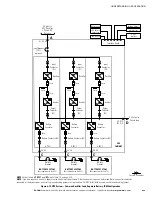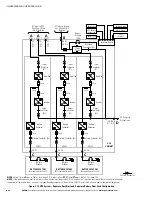
UNDERSTANDING UPS OPERATION
EATON
Powerware
®
9395 UPS (650–825 kVA) Installation and Operation Manual
S
164201725 Rev 2
www.powerware.com
6−3
Static
Switch
Rectifier
Inverter
K1
K3
Battery
Converter
Battery
Battery
Breaker
Main Power Flow
Trickle Current
Energized
De−Energized
Closed
Open
Breakers
Contactors
Static
Switch
K5
Rectifier
Inverter
K1
K3
Battery
Breaker
Main Power Flow
Trickle Current
Energized
De−Energized
Closed
Open
Breakers
Contactors
K2
Bypass Input
Rectifier
Input
Output
Bypass
Breaker
(CB4)
Input
Breaker
(CB1
NOTE
On an UPS configured as an IOM, the bypass input, static switch, bypass breaker (CB4), and K5 are not present.
Figure 6-2. Path of Current Through the UPS in Normal Mode
The inverter produces a three−phase AC output to a customer’s load without the use
of a transformer. The inverter derives regulated DC from the rectifier and uses IGBT
devices and pulse−width modulation (PWM) to produce a regulated and filtered AC
output. The AC output of the inverter is delivered to the system output through the
output contactor K3.
If the utility AC power is interrupted or is out of specification, the UPS automatically
switches to Battery mode to support the critical load without interruption. When utility
power returns, the UPS returns to Normal mode.
NOTE
Bypass mode is not available on an UPS configured as an IOM.
If the UPS becomes overloaded or unavailable, the UPS switches to Bypass mode.
The UPS automatically returns to Normal mode when the overload condition is
cleared and system operation is restored within specified limits.
If the UPS suffers an internal failure, it switches automatically to Bypass mode and
remains in that mode until the failure is corrected and the UPS is back in service.
















































